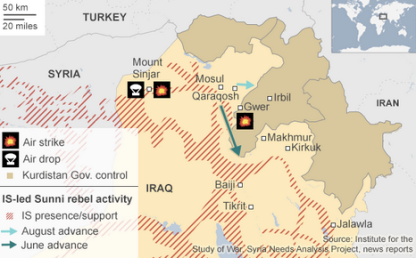Fighting between Israel and Palestinian militants in the Gaza Strip is currently on hold after both sides agreed to a short-term ceasefire. The conflict has seen the deadliest violence in years and there is no sign of a long-term truce yet. Here is a look at what is going on.
What is the root of the conflict?
The Gaza Strip, sandwiched between Israel and Egypt, has been a recurring flashpoint in the Israel-Palestinian conflict for years.
Israel occupied Gaza in the 1967 Middle East war and only pulled its troops and settlers out in 2005. Israel considered this the end of the occupation, but it still exercises control over most of Gaza’s borders, waters and airspace. Egypt controls Gaza’s southern border.
Israel has imposed tight restrictions on the movement of goods and people in and out of the Gaza Strip, measures it says are vital for its own security.
However, Palestinians in Gaza feel confined and are suffering socio-economic hardship. The dominant Islamist Palestinian movement Hamas and other militant groups say the restrictions are intolerable.
Hamas’s charter is committed to Israel’s destruction but in recent years it has said it will consider a long-term truce with Israel. It cites Israel’s continued occupation of the West Bank and East Jerusalem as reasons for its attacks on the Jewish state before and after 2005.
It says it is also acting in self-defence against Israeli air strikes, incursions and other military assaults.
What caused the latest escalation?
Rocket fire from militants in Gaza and Israeli air strikes on the territory increased after the abduction and killing of three Israeli teenagers in June, which Israel blamed on Hamas and which led to a crackdown on the group in the West Bank. Hamas denied being behind the killings. Tensions rose further after the suspected revenge killing of a Palestinian teenager in Jerusalem on 2 July, after which six suspects were arrested.
On 7 July, Hamas claimed responsibility for firing rockets for the first time in 20 months, after a series of Israeli air strikes in which several members of its armed wing were killed.
The next day, Israel launched Operation Protective Edge, which it said was aimed at stopping rocket attacks and destroying Hamas’ capabilities.
Since then, there have been thousands of air strikes and thousands of rockets have been fired.
Analysts point to the fact that Hamas has become increasingly isolated in Gaza after losing the support of its former staunch ally Syria and to a lesser extent Iran, and seeing the Egyptian authorities crack down on smuggling tunnels following the overthrow of Islamist President Mohammed Morsi. Attacking Israel, they say, may be a way for Hamas to try to boost its popularity and obtain concessions in any eventual long-term ceasefire.
Why has it been so hard to get the sides to agree to a long-term ceasefire?
There have been multiple efforts to get both sides to agree to a ceasefire, but truces have been short-lived.
The first truce plan was proposed by Egypt after one week – Israel accepted it but Hamas said it was not consulted and later on rejected it as “a surrender”.
There were several attempts to stop the fighting over the next four weeks, including trying to achieve pauses for humanitarian reasons. There were brief respites but none which endured. Israel says it accepted successive truce proposals but resumed fire after continuous rocket attacks from militants.
On 4 August, Israel and Hamas agreed to an Egyptian proposal for a 72-hour ceasefire, beginning at 08:00 local time (05:00 GMT) the following day.
Both sides sent representatives to Cairo to participate in indirect negotiations on a long-term truce. The Israeli military also announced that all its forces had withdrawn from Gaza and taken up “defensive positions” after completing their main goal of destroying tunnels used by militants.
Hamas said it would accept a lasting ceasefire so long as it led to a lifting of the blockade of Gaza – something Israel insisted it would not consider without the demilitarisation of Gaza.
Israeli officials said the government was willing to extend the ceasefire after three days of talks, but Hamas did not agree and rocket fire resumed on the morning of 8 August. Israel subsequently launched a series of air strikes and recalled its delegation from Cairo, saying it would not “negotiate under fire”.
After a surprise deal on 10 August for a second 72-hour ceasefire, Israeli negotiators returned to Cairo to resume indirect talks with the Palestinian delegation on 11 August.
Negotiations have been complicated by the Egyptian government’s stance on Hamas, which it considers a threat. The US has no formal contacts with Hamas, which it considers a terrorist group, and while Qatar and Turkey, both supporters of Hamas, have been involved in ceasefire discussions, Israel does not trust them.
How long will the conflict go on for?
The fighting has now lasted longer than the previous Israel-Gaza conflicts in 2008-09 (22 days) and 2012 (eight days).
He has said Operation Protective Edge will carry on for as long as it takes to restore quiet and safety for Israelis.
According to the Israeli military, after the first four weeks Hamas’s rocket arsenal was depleted by about two-thirds, through air strikes, ground operations or the firing of the rockets.
The Israeli military said at the same time that it had destroyed the last of the 32 tunnels inside Gaza that had been dug by Hamas to infiltrate southern Israel. However, officials said some tunnels might have gone undetected and that troops were prepared to destroy them in the future.
Hamas has vowed to fight on until it can be guaranteed the Israeli blockade will be lifted, and insisted it will not accept the presence of any Israeli troops in Gaza.
What are the two sides’ goals?
Israel’s main declared aim is to stop rocket fire from Gaza once and for all. It has also said it aims to destroy Hamas network of tunnels running between Gaza and Israel and wants the territory to ultimately be demilitarised. However, Mr Netanyahu has warned Israelis that there is no guarantee of “100% success”.
Palestinian militants have used tunnels to carry out attacks, some of which have been thwarted by the Israeli military. Israeli soldier Gilad Shalit was abducted by Hamas gunmen, who ambushed Israeli troops via a tunnel in 2006. On the morning of the day the ground offensive was launched, the Israeli military intercepted 13 militants who had used a tunnel to infiltrate Israel, and were believed to be planning to attack a nearby kibbutz.
Hamas’ political leaders say they will only stop fighting when there is an end to the blockade of Gaza. The group’s armed wing though has said it will only accept a long-term ceasefire if:
- Israel stops “all aggression” in the West Bank, Jerusalem and Gaza
- Commits to the 2012 ceasefire
- Stops trying to undermine the recently formed Palestinian unity government
- Frees prisoners released in exchange for Gilad Shalit in 2011 but who have recently been re-arrested
How come civilians are bearing the brunt?
Gaza is a small territory with a large population and Palestinian officials say many of the casualties were caused by air strikes in residential areas. President Mahmoud Abbas has accused Israel of committing “genocide” while human rights groups have warned Israel that air strikes in densely populated areas or direct attacks on civilian homes could violate international law.
Israel has said the homes it has bombed belonged to senior militants and served as command centres where rocket attacks were co-ordinated. It says militants deliberately fire rockets from civilian areas and store rockets in places like homes, school and hospitals – a charge Hamas denies.
Israel also points out that the hundreds of unguided rockets that have been fired at its territory directly threaten its civilians.
Long-range rockets have been launched towards population centres such as Tel Aviv and Jerusalem, as well as further north. Human rights groups have said the firing of indiscriminate rockets endangers civilians and constitutes a war crime.
The two sides have fought wars before. How did they end?
Israel launched a ground offensive in December 2008 dubbed Operation Cast Lead in response to rocket fire. It ended when Israel declared a unilateral ceasefire 22 days later, saying its goals were “more than fully achieved”. An estimated 1,300 Palestinians were killed, many of them civilians. Thirteen Israelis also died, including four soldiers in a “friendly fire” incident. Gaza’s civilian infrastructure was damaged extensively.
Four years later, Israel launched Operation Pillar of Defence, again with the stated goal of stopping rocket fire and crippling Hamas’s capability to launch attacks. Eight days into the operation, Egypt brokered a ceasefire agreement that included a promise from both sides to stop attacks. At least 167 Palestinians and six Israelis were killed.
What are your thought?
Thanks,
Digestible Politics

